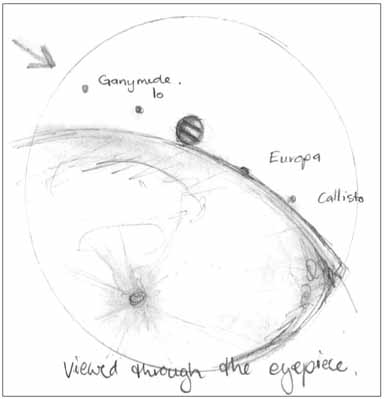
Ilustration Beth Bassett Click for hires image.
By Beth Bassett
From the BDAS Newsletter, March 2005.
Used with permission.
With much anticipation we had waited for this celestial event and had planned our viewing in advance, hoping the weather would be fine. The camera was to photograph the event wide field using the 300 mm telephoto lens. This meant that it would capture the whole of the moon, Jupiter's approach and departure in a sequence of shots that could played with later. Because the moonrise can only be viewed from the front of our house the camera was mounted on the tripod to be moved to the darker backyard and linked to the computer for the actual occultation.
It was decided to view the event craters and all. So we wheeled Persephone, the girl-power name for our 16" truss Dobsonian, out to the middle of the backyard hoping the moon would clear the trees before the occultation began.
We started the evening with a collimation of the telescope, so we would have the best possible view. To check the collimation and just for fun we did some deepsky viewing before the glow of the moon lit the sky. Swinging the Dob around to the north we took a look at Saturn. It was a delight with the Cassini division, the ring shadows and the moons clearly visible. Satisfied with the telescope's performance we took the camera to the front step to watch the moon rise.
The moon soon appeared glowing large and yellow as it rose above the Earth's horizon. It was followed by the rise of Jupiter slightly below and to its right. As Jupiter cleared the horizon it appeared like a large yellow baby that followed its parent's journey into the night. The real excitement began about 11.15 pm as in the backyard the moon rose above the tree line and the first glimpse of the moon blasted a stunning beam of light at my dark adapted eyes. Ugh! The nil-density filter was quickly fitted to a wide field 40 mm 13° eyepiece and the view was stunning, but not big enough for me!
 Ilustration Beth Bassett Click for hires image. |
Keith, sitting inside at his computer controlling the camera and viewing the pictures on the monitor, was missing the live magnified action that I was enjoying. From time to time, I was disturbed by the occasional request out the window to focus and center the camera. Reluctantly leaving my telescope, during one camera correction, I grabbed the 18 mm eyepiece. Back at the scope, I bunged it in the focuser. The magnified view made me gasp in awe as it resolved into a large slice of the moon's edge and an approaching Jupiter, complete with brown planetary bands, and lined up in a row, the four Jovian moons.
I called Keith outside to share the unbelievable view. Taking turns at the
eyepiece we watched the approach of the planet. First the moon Callisto
disappeared behind our moon followed by Europa. As we watched Jupiter
seemed to touch the moon then sink below the horizon and slowly the first
planetary band followed,then the equatorial region. At this point it became
obvious that Jupiter would not totally disappear but skim along the South West
limb of the moon. Jupiter continued to sink behind the moon obscuring the second
ring and leaving only the polar region visible.
 Photograph Keith Bassett |
During one of the changes between views we had noted that to the naked eye Jupiter had totally disappeared behind the moon. What had the camera recorded? Back inside Keith reported that the camera's view, though smaller and without the Jovian moons had been much the same as the telescope. Watching through the eyepiece as Jupiter and its trailing moons Io, then Ganymede emerged I was struck by the power of the event and pondered on the effect this must have had on ancient man. It gave me something to think over as we packed away the equipment and returned to mundane things.
Beth Bassett